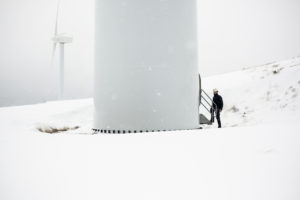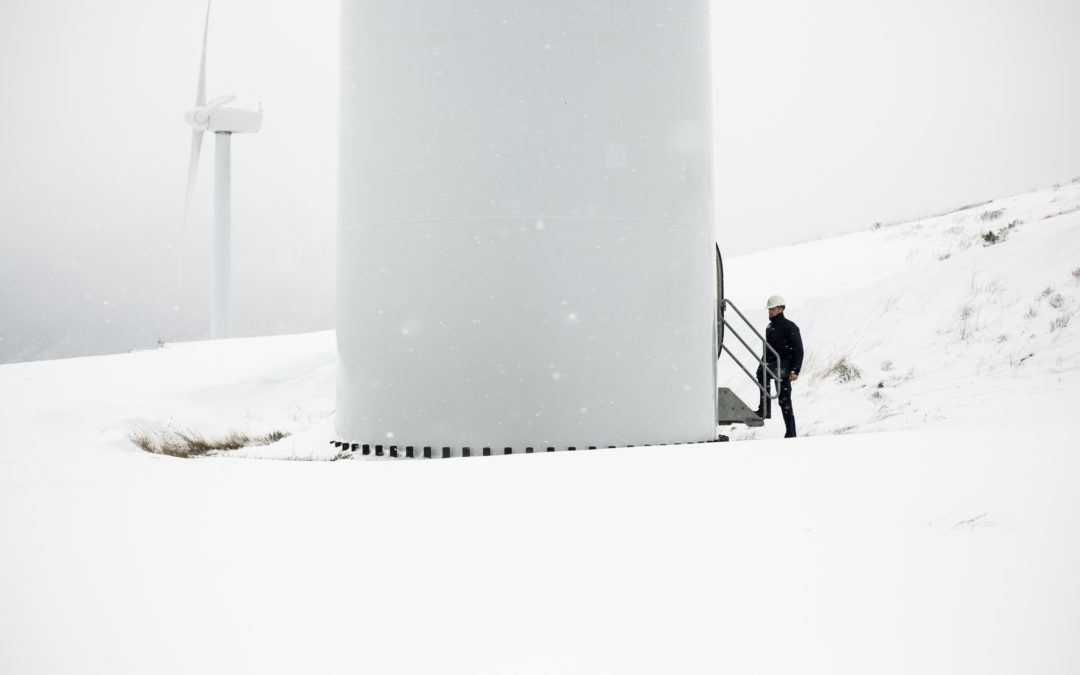Although it is still warm outside, we shouldn’t forget that winter is coming… And with winter comes ice which can be an issue for a wind turbine, not only technically speaking but can also cause liabilities issues to asset owners. Indeed, not only responsible for technical damages, ice can also be dangerous for surroundings and third party leaving nearby the affected wind farm.
As safety comes first here at Greensolver, this article will explore how to mitigate the impact of ice on a wind turbine.
Ice: form & issues
Ice, on a wind turbine, comes under one of this three types:
- Wet snow: will occur in air temperature conditions just above freezing point. The snow will stick due to its partially liquid content to the cold surfaces it lands. When the temperatures drop below freezing this will turn to ice.
- Rime: is formed when the moisture from the air comes into contact with a surface that is below freezing point. Rime tends to be formed on the wind ward side of the turbines. Rime has a white colour.
- Glaze: forms when liquid precipitation strikes a surface when the temperature is below the freezing point. Glaze normally forms at temperatures between 0 and 10˚C. The liquid will freeze into ice, the glaze is transparent.
Performance of the wind turbine will be the first affected with ice issues. We have seen cases when, in case of glaze, a production loss between 80% and 91% was detected.
Ice can also have an impact of the turbine balance, resulting in different kinds of errors, such a Yaw error that can cause a standstill for a long period.
Another problem is ice shed. This can occur both during operations as well as during the periods the turbines is on stand still. When ice is shedding it can lead to personal injuries to people, or damage to structures or equipment in the vicinity of the turbine(s). Although over 50% of the shed ice will fall directly underneath the blades, the rotation of the blades or the wind will lead the ice to fall at a longer distance from the turbine. To prevent ice dispersion, all turbines need to be shut down, with the exception for controlled reel off, where the RPM is lower than 1. The danger zone for ice shed at a turbine at standstill is determined by the position of the rotor blades.
It is also important to note that ice dispersion can lead to personal injuries for which, asset owner can be held responsible.

Engineer accessing to the wind turbine, in a wind farm on winter.
Detect, mitigate & restart
Icing on blades has to be detected by the Asset Managers, using three different ways:
- Deviation in the power curve, this combined with the weather data makes the suspicion rise of Ice growth on the blades.
- Turbines can be fitted with individual software to detect ice; this software detects the deviation in the power curve together with amongst others temperature this will make the turbine shut down on misbalance.
- The owner can also choose to fit their turbines with special Ice detectors and/ or monitoring systems on one or all the turbines within a wind farm. These detectors/ systems monitor the conditions and in case the conditions indicate Ice growth, the wind farm is shut down.
As stated earlier, ice can also cause injuries to public & surroundings structures and liability of the asset owner engaged. risk categorisation of the turbine location is the crucial for measures to be taken and The Netherlands has developed a system for this. We distinguish three different level of location:
- A-locations, being a free area away from roads and closed for the public, the location is qualified as being non-critical.
- B-locations are viewed as being limited critical. Those locations are situated near roads and building not in the public domain.
- The Critical locations, also called C-locations are locations where the turbines are close to buildings and roads where pedestrians and cyclists are present.
The Netherlands has developed its one system in order to mitigate risk and depending on the location of the wind farm, different mitigation measures are to be taken:
- For turbines located in A-locations: A-locations signage and a warning to the landowner/ users can be sufficient.
- In case of a B or C location, additional measures like safety plans/ procedures, warnings and if needed to turn the nacelle in a fixed position. Also, an evacuation of the area is one of the possible outcomes of the Risk Assessment. The special plans and procedures for ice related emergencies need to be continuously updated and annually reviewed.
In France, such classification doesn’t exist, however it is mandatory for every wind farm to have a sign at a good distance, indicating the risk of ice projection – even in south of France regions, less impacted by ice.
When the conditions improve and the Ice on the turbine/ blades is melting one can start thinking about the restart of the turbine(s). However, before any restart the turbine has to be inspected, and only if the turbine is free of ice it can be restarted. This inspection can be either performed:
- Using a camera system: specially trained staff will assess the state of the turbine and the blades, if all is cleared the turbines will be remotely restarted,
- Using a competent trained staff who will go on site and inspect the turbine. If inspection shows the turbine is free off ice, the turbines will be either remotely or manually restarted.
If you have queries about how to address safety issues, Greensolver has many years of experience of safely managing Wind Assets, for advice please contact us. Would you also like to know what kind of affect snow and ice could have on your solar plant? Our solar specialist can advise you. Let us help you making your assets winter proof!

